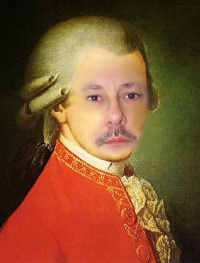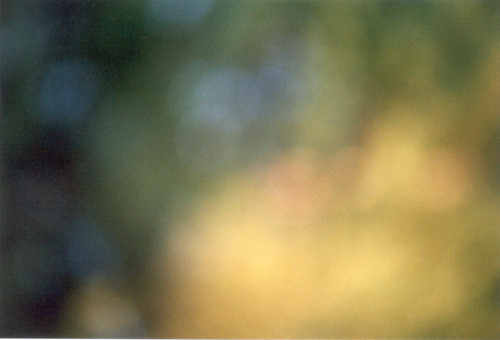A 365-Day Project
"We Are All Mozart"
A project to create
new works and change
the perception of the
music of our time.


 June 29, 2006
June 29, 2006 
That music be inevitable is the first of musical principles.
This wasn't entirely clear in yesterday's commentary. It's not that the listener would know what's coming next, but rather that, upon hearing what does come next, the listener believes instantly that it could have been no other way -- the listener is gratified.
How can this be the case with aleatory? Or with improvisation? Inevitability doesn't mean the only choice. Many choices are inevitable because art has myriad layers and textures. Inevitable is certain, unavoidable, inescapable. If it's death, then it bespeaks the event, not the manner. And should it be not death but a dominant chord, where would it resolve? The inevitability suggests nothing except that, for where it is going, it could have been no other way at that moment. Perhaps it is the tonic coming next; perhaps it is false. Whatever comes, the listener believes it could have been no other way, which is the composer's artistic sleight-of-sound.
Quasi-diversion: Life is a miserable sumbitch when it comes to inevitability. Certainty is always retrospective. And if it feels like my -spective is presently intro-, you're right. "We Are All Mozart" seemed inevitable, presented with the perfect moment in time. Was I wrong? Is there some other inevitability that will be clear on January 2, 2007?
Life after Kalvos & Damian has not been difficult so much as confusing. The inevitable week after week has been replaced by not so much silence as something more occasional that has lost the momentum of listenership. We had listeners, more than we thought. But they have not carried into WAAM, nor into performances, nor into, well, much of anything. It's as if we weren't so much stepping onward as stepping off-ward.
Which brings me back to the first principle. What is inevitable now, in music and in life? For clues, I'll wrap up the methods of my work beginning in 2000, just after my discovery that "pretty" was in my vocabulary.
Quince & Fog Falls, 2000
The natural world has played a part in my work as much if not more than Stockhausen's mountains and Cage's boroughs influenced theirs. It's not a Beethovenian countryside thinking, but rather a search for source material -- the inevitable question of 'where do you get your notes.' (I'll save for another day the issue of sound objects and electroacoustics, which are not note-bound.) Quince was indeed written by the brook, where the constant sound of the water and the shape of the land contributed to the sound and shape of the music itself. The cello plays the shape of the terrain as I look from left to right, and becomes a kind of passacaglia. Written for the unusual requirements of Essential Music (cello, piano, flute, percussion), Quince assembles itself into a coloristic struggle in background-foreground music, a layering development rather than any of the typical tools, a sort of baroque terraced dynamics, but with pitch and color content. It was successful in structure and evocative in sensibility, and built to be inevitable but not quite memorable.
Which brings me to a pique. Quince was a pseudo-commission, one of those "we'd really like a piece from you, but we have only a small honorarium budget" requests. I don't mind that. It gives me a chance to exercise my compositional experiment-muscles while creating music that is part product, part gift. Fond as I was of Quince, Essential Music never acknowledged, paid for, or played the piece. Did they hate it? Possibly. Did they reject the effort it would demand? Possibly. Did they not understand it and put it aside for another day? Possibly. There is no way to know because I have since been consistently ignored. This is a plague in the field of new nonpop -- many performers who, for reasons I cannot understand, have developed and proudly maintain a deep sense of rudeness. It applies to performers, conductors, and even presenters. I have spoken before about composers coming hat-in-hand, as some sort of beggar class. One of the points of "We Are All Mozart" is to change that relationship. The change has yet to begin.
Back to the music...
Snare:Wilding, 2000
Following the previous year's bellyloops, I had found a new 'internal' audience for electroacoustic music, as well as an external audience who did not know my name. That was good. I might be 20 or 50 -- or a dog. bellyloops is actually a noteful piece, weaving sampled voices into a defined sonic fabric. The result is a keening. The piece was a very personal and almost primal response to a so-called "wilding" in New York's Central Park, an extreme sexual harrassment and intimidation, a kind of psychological terror. Pitched "ah" and insistent "no" alternate in a chilly rise, sighing inconclusively. The piece is best heard as a repeating loop, where the insistence is ultimately chilling.
HighBirds (Prime), 2001
Mirrored Birds, 2001
Part of my ongoing birds series, these two compositions are at opposite ends of the sonic spectrum. Written in February and December respectively, they were also separated by the first great American tragedy of the 21st century. It would seem that the thread of style would have become unwound or ripped apart, but not so.
HighBirds (Prime), subtitled "In Memoriam Iannis Xenakis," is a tribute that dips back into the noise of his stochastic approach, but recloaks it in small, repeating shapes based on birdsong. It began as an electric guitar duet, but with the death of Xenakis it changed character, shucking through-composed 'dot music' and inquiring of five bird calls for sonic maps of color, pitch, and density. A sonic alphabet was built from the extracted and several-times-transformed spectral images. The results are almost organic. For the guitar parts, multiple channels of information were drawn out of five of the original multi-color spectral transformations, the results translated into notation that was worked for shape, color, and dynamics.
The melodic material from Quince migrated through several compositions, including The Sub-Aether Bande, Rose Quartz Crystal Radio and Mirrored Birds. In the honored tradition of stealing from oneself, I redeveloped the implication-laden flute material several times. Mirrored Birds uses a quasi-minimalist substructure in C minor/lydian overlain with the (now) impressionist flute solo. It is symmetrical (à la Messiaen, though without rigorous non-retrogradable melodies), orchestrated with the feel of Milhaud, nodding to Zappa in the wind rhythms. The three continuous movements pivot on a flute cadenza. Written for Louis Moyse's 90th birthday, it begins with six notes from his First Sonata slow movement, quickly devolving into fragmented horn calls. The retrograde half exploits the 'tails' of note rhythms to create more complex interactions. The structure and techniques, though, are entired subsumed by a nonstop sonic rush.
Tirkíinistrá, 25 Landscape Preludes, 2002
The search for source material becomes exasperating. Bird songs, spectral images, photographs. Tīrkíinistrá is a set of twenty-five one-minute préludes based on photographs taken on my land in late 2002. Each miniature was created by recomposing the raw design and color information in a photograph into frequency changes and densities. As with HighBirds, the raw material was extracted many times until it reflected my idea of the photograph. It was roughly worked through twenty-four modes and scales as if mirroring the structure of a folk song, and then refined and polished. Listening to all twenty-five préludes should expose the feel of a Vermont autumn. Photos are placed in the score with their respective préludes, along with a dynamic map drawn from it; the performer sculpts its shape in sound. Tīrkíinistrá was a surprise. I had no idea how compelling this piece was until I heard it in the hands of pianists Michael Arnowitt and Dante Oei.
Spammung, 2003
By Still Waters, 2004
And now I return to the extended voice, with two pieces again paired for their differences. Spammung, which I commented on briefly last week, is 100% expressive madness. What can be lost in watching it performed or concentrating on the lead voice is the rest of the piece -- eight software speech readers attempting to read a text made of spam subject lines (real and nonsense words in many languages) as if that text were written in 'their' languages. The raw material was then processed to produce a bedstraw of multilingual conversation, none of it discernable but all of it present. (It's also difficult to hear with point-source projection. What Spammung probably needs is a really good diffusion engineer and a multichannel remix. Some day.) Spammung is also fun, inverted tribute as it is to Stimmung, completely flattening out Stockhausen's "Formschema" and replacing live, multi-voiced subtlety with a frenetic soloist over an inflexible computer-sourced drone.
By Still Waters (K Vodam Tixim) is equally incomprehensible, but from a micromalist viewpoint. The composition is a solo lament to the victims of Beslan, a particularly disturbing and intensely personal slaughter of innocents. With an unflincing drone on one note, the vocalist sings an expressive and coloristic line of harmonic text using only the vowels of the 23rd Psalm in Russian, unable to close mouth or throat to pronounce a consonant, in a kind of unending scream hardly rising above silence. By Still Waters not only exposes the vocalist (who, fortunately, was the incomparable Beth Griffith at the premiere) but also the composer. Each successive sound must be (again) inevitable. The piece is a linear expansion of a kind of chant, microtonal and resonant, moving in and out of close melodic motion in an arch of (for lack of a musical term) disbelief.
What Now?
The past two years have come as a crisis. I may have lost my way, found a new one, or collapsed into conservatism. I'm not certain, but some compositions contain elements I would not have touched as a younger composer. Is it age or laziness? I don't think so. (For that matter, is "We Are All Mozart" an attempt to fend off laziness? Not sure about that, either.) But two pieces represent the lopsidedness of the trend as I begin the great downslide of mortality: L'Estampie du Chevalier and Clouds of Endless Summer.
I love this piece. It is a kind of rondo based on harmonies from rural Appalachia, with the material (really just two themes) knit together into an expressive, abstract dance (vaguely) modeled on the 14th century French estampie. It also uses an expressive device I learned as a teenager from Beethoven's Coriolanus overture -- the composing of rhythmic shifts at a fixed tempo rather than the use of frequent subjective markings (such as "rubato" or "rall" or "accel"). For the performers who premiered it in Belgium, it turns out that this was fiercely difficult as they wanted to put in expressive content over and above what was written -- making it impossible for them to play together. The insecurity that came from the lack of synchronicity was nearly fatal to the performance. The Estampie has come in for its share of criticism from colleagues.
Clouds of Endless Summer, 2006
This is not a 'great' piece. Instead, it is a kind of retrospective experiment, combining an ostinato piano bass with eloquent lines intertwined in an Ars Nova way and folding in a central quasi-minimalism section. In other words, it's a mongrel with a romantic left curve. Maybe I'll leave it at there, because I'm not sure where it's going now.
It's raining again, so I'm in the mood for some very good jokes.

The photograph for Tirkíinistrá Prelude #5. Each source photo is printed in the score.